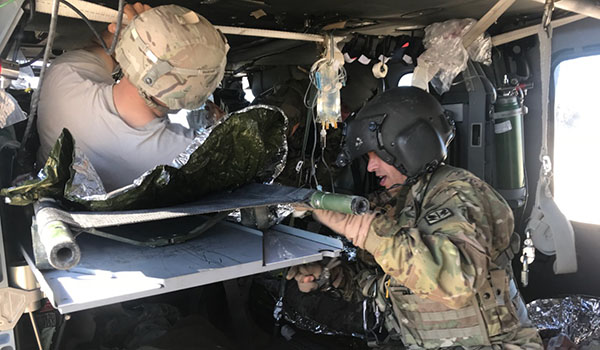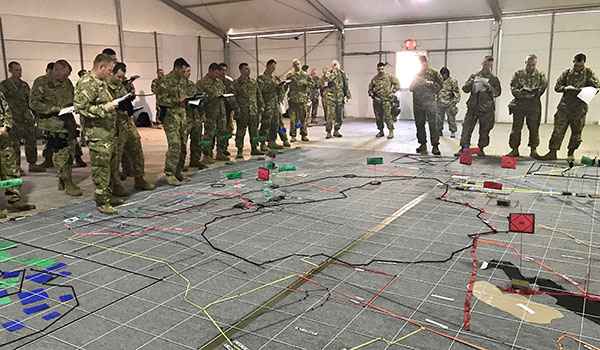
Reserve / By COL Joseph W. Bishop: Our National Guard Aviation formations are ready and eager to support our nation’s operational missions. Recently, the 449th Theater Aviation Brigade (TAB) was tasked with the tactical employment of aeromedical evacuation, attack helicopter, security, air movement, air assault, and reconnaissance support to coalition forces throughout Iraq, Syria, Kuwait, Jordan, and Turkey.

Patients being evacuated on-board a 449th Aviation Brigade Task Force MEDEVAC aircraft during a culminating training event (CTE). The CTE was an air assault utilizing all elements of the Brigade Task Force./ ARMY NATIONAL GUARD PHOTO
The mission was to degrade and destroy the Islamic State of Iraq and the Levant (ISIL) Iraq from December 2017 to September 2018 in support of OPERTIONS INHERENT RESOLVE (OIR) and SPARTAN SHIELD (OSS).
A True Team Effort!
The mobilization and recent combat success of 449th TAB and most recently the 35th CAB might seem routine; however, it requires a complex set of movements and synchronization within the ARNG and across the Army Aviation Enterprise. Mobilization training for the Soldiers of the 449th TAB began over two years prior to this deployment. Assembled from 13 different states, Task Force Hurricanes assembled one of the largest National Guard Aviation task forces to mobilize out of Fort Hood, TX in over a decade. The CAB’s operational control spanned three battalion-size task forces, six countries, and thirteen operational locations. For the Reserve Component, mobilization and receiving an order for an Active duty assignment is a culminating event within the complex process of Army Force Generation.

The 449th Aviation Brigade Leaders conduct a Rehearsal of Concept Drill in preparation for its culminating training event (CTE) at Ft. Hood, TX prior to deployment.
Achieving a successful mobilization demands effective coordination to influence specific activities and key lines of effort. Force generation for ARNG Aviation units is an enduring reality implemented in four- or five-year sustainable readiness cycles. The States and units monitor unit progression in the cycle through a force availability tracking system. For the purposes of this discussion, I am focusing on the period of time from the Notification of Sourcing (NOS) to the unit’s actual mobilization date, approximately twenty-seven months prior to the unit’s deployment.
Just prior to the NOS NGB, in consultation with State Army Aviation Officers (SAAOs) and Mobilization Readiness Officers (MROs), develops an initial mobilization task organization diagram that portrays the mobilization mission command, units and associated unit alignments. The task organization serves as an underpinning document to the NOS, mobilization and the eventual deployment. The NOS memorandum, which is published about twenty-four months before the mobilization date, is the official notification to the States of a planned mobilization. The NOS sets in motion more deliberative mobilization planning.
166th Aviation Training Brigade takes on an active role in mentoring, advising and assisting the ARNG aviation units through mobilization. The Department of the Army publishes the unit mobilization order approximately six months from the mobilization date and subsequent unit member orders are published three months later.
The deploying units, approximately two years prior to mobilization, focus on the individual readiness by conducting a Soldier Readiness Processing (SRP) event. Typically one year prior to mobilization, command teams are formed, key staff in position and the units conduct an external evaluation, working with First Army and other enablers, to conduct events such as a Warfighter, and/or combat training center (CTC) event to develop brigade/battalion staffs and supporting units in some of the most challenging and realistic training in the world.
Every mobilization is slightly different with its own inherent characteristics. However, the active lines of communication from the strategic to the tactical level as well as the state to state dialogue are invaluable in setting the conditions for a smooth mobilization. Once pre-mobilization tasks are completed, Aviation units all come together at North Fort Hood to train collectively as a deploying unit. For up to eight weeks, a series of collective tasks at company to brigade level are completed to stress formations by working through operational risk challenges, communication processes and standard operating procedures. An evaluated culminating event puts all facets of Army Aviation into a scenario driven mission ensuring the ARNG unit is ready to deploy. It all starts at the individual level, teamwork, leadership and hard work make formations merge into one Aviation unit and capable of conducting the assigned mission.
The concerted effort by all involved results in a mobilization process that minimizes distractions on Soldiers and Leaders and allows dedicated, selfless Guardsmen to focus on the task at hand; the mission and a successful deployment.
Citizen Soldiers, at the Ready!
COL Joseph W. Bishop is the chief of the Army National Guard Aviation and Safety Division located in Arlington, VA.








